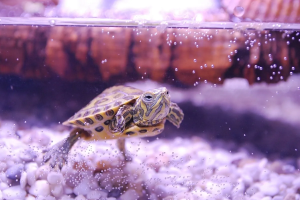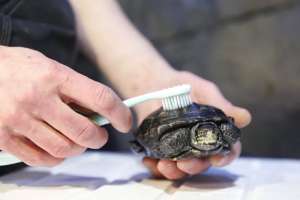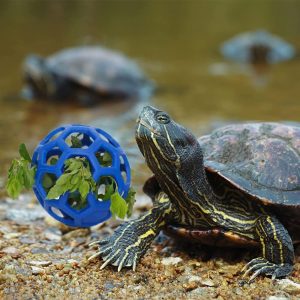
We here at Passionately Pets not only care for dogs and cats but for all small animals including reptiles, fish, birds, rabbits, guinea pigs and even hermit crabs. Caring for turtles is one of our favorites because they can be bursting with personality and are super fun to watch.
What Kinds of Turtles Make Good Pets?
The most common turtles owned as pets are the Box, Red-eared Slider, Painted, Reeve’s, Wood, and Caspian Pond turtles. Most of these are aquatic with flat streamlined shells, but the Box turtle is a land dweller with a more rounded dome-like shell. Each of these turtles usually has a lifespan of more than 25 years, some making it into the 80 year range, like the Box turtle.
Adult shell size can be anywhere from 6 to 12 inches in diameter. Adopted turtles or those from a pet store are usually juvenile and still have lots of growing to do. You should expect to need a 75 gallon tank to house an adult turtle. Smaller juvenile turtles can be kept in a 40 gallon tank until they outgrow the space. That said, bigger tanks are easier to clean and turtles like to have more space to move, so it’s not a bad idea to start with a big tank.

Turtles enjoy water habitats or ponds to dip in, depending on the type. The Red-eared Slider, for example, enjoys a habitat like an aquarium with room for swimming and spots above water to rest and relax. The Box turtle, however, likes a land environment with only a small wading pool for cooling off.
How to Care for a Pet Turtle
Turtles require more attention and care than fish, but less than a more active animal like a dog or cat. Still, before you buy a turtle, you should know how to care for it. This may help you prepare for the required tasks ahead. Follow these steps to have a happy turtle.
1. Set Up a Tank

A turtle’s indoor habitat should be at least 40 gallons to allow for growth to adult size. It should also include a heat lamp for basking as well as a land area or dry area and swimming area or wet area. Make sure you read about the turtle you plan to buy so you can provide the right living environment with the correct ratio of land to water.
2. Set Up Temperature Control
Turtles are cold-blooded critters who need a fairly constant temperature in order to do well. Turtles prefer to live in a temperature between 60 and 90 degrees Fahrenheit. Some turtles do all right if the temperature drops down to 50 degrees at night, but anything lower than that can cause a turtle to go into hibernation or get sick. In addition to the basking lamp to heat the air, your turtle’s space will require a submersible heater for the water. For optimum health, turtles need exposure to either a UV lamp or direct sunlight for 10 to 12 hours.
3. Find Out How Much Your Turtle Should Hibernate
Since turtles have varying lengths of hibernation time, you should know how long to expect your turtle to be inactive and how to provide the best environment for it in the meantime.

4. Provide Food
All turtles (but not all tortoises) are omnivores, meaning they eat both plants and meat. Aquatic turtles can eat a variety of foods including fresh, frozen, flaked and pelleted foods. Fresh foods that are healthy and safe for turtles include insects like grubs and crickets, earthworms, small fish, and dark leafy greens such as kale and collard greens. Adult turtles only need to eat three to five times per week, and baby turtles may need to eat up to twice a day. In addition, turtles need a calcium supplement, usually in the form of a powder, dusted on their food two to three times per week.
5. Clean Tank and Change Water Frequently
Because turtles eat and defecate in their water, their enclosure should be cleaned regularly, even if you have filtration systems or other regular maintenance devices. Filtration in a water aquarium is a must, and if the tank starts smelling it is because the water is dirty and needs to be changed.
6. Do Not Play with Your Turtle Often
Turtles get stressed easily when handled. They aren’t very good playmates and are better treated as something to look at rather than touch. Never drop or throw your turtle as they can get hurt easily, even with their hard shells.
7. Wash Your Hands
Turtles carry salmonella which can cause sickness in young children, immune-compromised individuals, and the elderly. Always wash your hands after handling a turtle or any part of their habitat to avoid getting sick.

Bathing Your Turtle
To bathe your turtle, you just need a tub, a toothbrush, and a jug or pitcher of lukewarm water, preferably de-chlorinated. You should not use any kind of soap or shampoo on your turtle unless it is specifically recommended by your vet! Use a toothbrush and gently scrub the turtle’s entire shell, paying special attention to any areas of buildup. Remember that the turtle can feel his shell, so do not scrub too hard. Then scrub the turtle’s legs, tail, and neck, but be careful with these areas as they are more sensitive. Finally, scrub the turtle’s plastron (belly), and be sure to remove all algae and dirt between the scutes (each individual shape that make up their shell. Don’t worry if you find some scutes shed in their habitat – it just means your turtle is growing) or scales! Once your turtle is clean, you can rinse your newly shiny pet by pouring de-chlorinated water over it from a jug or pitcher before returning it to its enclosure.

Playing With Your Turtle
There are lots of ways to play with your pet turtle! Make an obstacle maze in the tank with empty shells, rafts, plants, and sticks! To make it more interesting, keep your turtle’s favorite treat at the end of the maze to lure it into the maze.
You can use ping pong balls and duckies as toys for your turtle. You simply put them in the aquarium, and they will float on the water. If you have a big enough tank, you can make a cave-like place for your turtle. This cave will act as a secure place for your turtle! Playing with your turtle is great for enrichment and bonding but also the perfect opportunity to get exercise in.
Though they may be tedious to care for, having a turtle as a pet is a rewarding and interesting experience. The various species of turtles have slightly different behaviors, so be sure to pick one that fits your personality. Soon, you’ll have a reptilian buddy to enjoy!





Leave a Reply